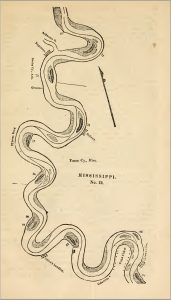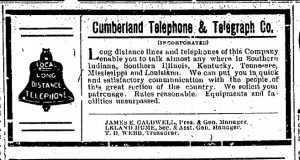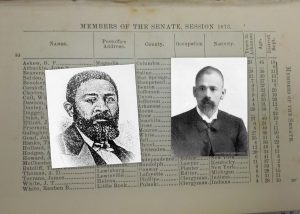Greenville, Mississippi’s City and Telephone Directories
Greenville, Mississippi has a solid run of city directories from 1913-present, with 1918-1926 as the most significant gap. Filled with names, businesses, addresses, and other information, directories are important resources for historians and genealogists. Directories are also a record of the town’s growth from a small county seat of under 1,000 people in 1865 to a city of over 40,000 in 1960.
The oldest directories that include Greenville are business directories along the Mississippi River. Having been rebuilt (and moved north) after the Civil War, Greenville was just a few years old in 1871, when the James’ River Guide wrote: “county seat of Washington co., Miss., is a small village. Population about 300.” While across the river, Chicot County’s more established seat, Columbia, seemed to be thriving: “IT is a very pleasant place, containing a number of stores, a court-house, and a population of about 400. Here commences the great cotton growing region, and the banks of the river are almost one succession of plantation. Just below this commences the growth of the Spanish moss.”
Two business directories centered around Vicksburg published in 1877 and 1879 also lists Greenville as a stop along the river just above “La Grange, Miss.”
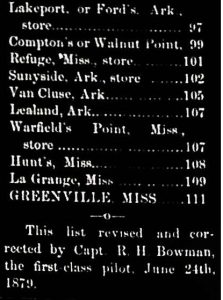
Business Directory of Vicksburg, Jackson, Meridian, and Stations on the Vicksburg & Meridian R.R. (Abel C. Tuttle, Vicksburg, Miss, 1879). Microfilm in Mississippi Department of Archives & History, Jackson.
During the last decades of the 19th century, town grew in population and modern amenities. The telegraph arrived in Greenville in 1877 and railroads crossed the town in all cardinal directions by the 1880s. Electricity came in 1888 and two years later a network of two electric streetcars was unveiled. That year the city reached a population of 7,642.
In the Lakeport Plantation Collection is a Greenville telephone directory from 1900. The directory, published by the Cumberland Telephone & Telegraph Company, contains 347 listings. In 1906 the Cumberland Telephone & Telegraph Company claimed their “Long distance lines and telephone enable you to talk almost any where in Southern Indiana, Southern Illinois, Kentucky, Tennessee, Mississippi and Louisiana.”
click to download the 1900 Greenville MS telephone directory
In 1961, the Delta-Democrat Times (March 1, 1961) chronicled “Greenville’s 40 year evolution from town to city” by comparing a 1961 directory to a newly discovered 1920 directory. Unearthed in a demolition of an old house, the 1920 directory was in the possession of Dean Loyd of 838 Bolivar St in 1961; today its location isn’t known and no copy of a 1920 Greenville directory can be found in any archive. According to the DDT, the 1920 directory had 1,428 listings compared to more than 11,000 in the 1961 directory. In that 40 year period, Greenville’s population grew from 11,560 to 41,502.
If you have Greenville city directory or telephone directory not in any archive, tell us about it.
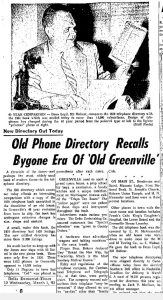
“Old Phone Directory Recalls Bygone Era of ‘Old Greenville’,” Delta Democrat-Times, March 1, 1961 (read the full article)
Where to access Greenville City Directories:
Ancestry.com has Greenville’s city directories (1913-1960) in its U.S. City Directories, 1822-1995 database. Ancestry requires a monthly fee to access its databases, but many local libraries and LDS Family History Centers offer access to patrons. Ancestry’s database is part of a microfilm collection offered by the Library of Congress & the Gale Group. Microfilm copies of the Greenville’s directories, 1913-1960 can be found in a number of libraries, including the William Alexander Percy Library in Greenville.
Ancestry.com ($): 1913, 1916, 1927, 1929, 1931, 1936, 1938, 1940, 1946, 1950, 1954, 1956, 1958, 1960
Delta State University/McCormick Collection: 1960-2001
Greenville History Museum:
- city directories: 1927 [photocopy], 1929, 1936, 1938, 1940, 1946, 1950, 1954, 1956, 1960, 1961, 1962, 1964, 1965, 1966, 1968, 1969, 1976-1993, 1996, 1998, 2000
- telephone directories: 1938, 1939, 1942, 1947, 1950, 1953
Lakeport Plantation: 1900 telephone directory
Library of Congress: 1913-1917, 1927-1940, 1946-1960 [1913, 1916, 1927, 1929, 1931, 1936, 1938, 1940, 1946, 1950, 1954, 1956, 1958, 1960]
Memphis Public Library: 1918
Mississippi Department of Archives & History:
- city directories: 1946, 1956, 1958, 1960, 1966, 1968, 1970, 1971, 1976, 1978, 1981, 1983, 1984, 1985, 1986, 1987, 1991, 1992, 1993, 1994, 1999, 2003
- telephone directories: 1972, 1975, 1977, 1978, 1979
St. Louis County Library: 1913-14, 1916-17, 1927-32
University of Memphis: 1918, 1975
University of Mississippi: ca.1913, 1918, 1975
University of Southern Mississippi: 1946, 1950-51, 1954, 1956, 1958, 1960, 1961, 1962, 1964, 1965, 1966, 1968, 1969, 1971-79, 1987, 1989
Washington County Courthouse:
- Greenville: 1981, 1989, 1990, 1991, 1993, 1994, 1995, 1996, 1998
- Leland: 1973, 1978, 1983, 1986, 1988, 1989, 1991, 1993, 1994, 1995
William Alexander Percy Library/Washington County: 1913-1932, 1936-1951 [microfilm]; 2010, 2011, 2012, 2014, 2015, 2016 [4 others with no date in catalog] [screenshot];
- Greenville–on shelves in Reference section: 1946; 1950-1951; 1954; 1956; 1958; 1960; 1961; 1964; 1965; 1966; 1968; 1969; 1970; 1971; 1973; 1972; 1974; 1975; 1977; 1978; 1979; 1981 [2 copies]; 1982 [2 copies]; 1983 [2 copies]; 1983 [cross reference directory]; 1984 [2 copies]; 1984 [cross reference directory] 1985 [3 copies]; 1986 [2 copies]; 1987 [2 copies]; 1989; 1990 [3 copies]; 1991; 1992; 1993; 1994 [2 copies]; 1995 [2 copies]; 1996 [2 copies]; 1996 [cross reference directory] 1997 [cross reference directory]; 1998; 1999; 2000; 2001, January [2 copies]; 2001, December [2 copies]; 2002; 2003; 2005 [2 copies]; 2006; 2007; 2008; 2009; 2010; 2011; 2012; 2013; 2014; 2015; 2016; 2017
- Leland: 1966, 1968; 1975; 1978; 1980; 1983; 1988; 1989; 1991; 1992; 1993; 1994; 1995; 1996.
Works consulted:
Keating, Bern. A History of Washington County. Greenville, MS: The Greenville Junior Auxiliary, 1976.
Willis, John C. Forgotton Time: The Yazoo-Mississippi Delta after the Civil War. Charlottesville: University of Virginia Press, 2000.

